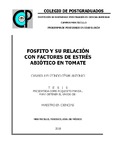Fosfito y su relación con factores de estrés abiótico en tomate
Date
2018Author
Casasola Elizondo, César Antonio
CASASOLA ELIZONDO, CESAR ANTONIO
Metadata
Show full item recordAbstract
En esta investigación se evaluaron los efectos que tiene la adición de fosfito (Phi) a partir de H3PO3 a la solución nutritiva de Steiner al 25% en una concentración correspondiente al 15% del P [0.0375 mol(+) m-3], en parámetros de crecimiento, concentración nutrimental en hoja, tallo y raíz, en parámetros bioquímicos y por último en parámetros relacionados con la fotosíntesis de plántulas de tomate variedad Cid, sometidas a los factores de estrés: salinidad por cloruro de sodio (NaCl), cadmio (Cd) y estrés nutrimental inducido por nitrógeno (N). El Phi tuvo efectos positivos en variables de crecimiento como número de hojas y de flores por plántula, altura y diámetro de tallo; asimismo, incrementó la concentración de macro y micronutrimentos en los órganos evaluados. Por otro lado, la adición de NaCl (50 y 100 mM) y de Cd (10 y 20 M) afectó de manera negativa el crecimiento de la planta, la concentración de clorofilas y los parámetros asociados con fotosíntesis. Por otra parte, conforme se incrementó la concentración de NO3- de 1.5 a 3.0 y 6.0 mol(+) m-3, aumentó el número de hojas y flores, área foliar, peso fresco y seco de hoja, tallo y raíz, altura de planta, volumen y longitud de raíz; así como en la acumulación de macro y micro nutrimentos en hoja, tallo y raíz; en los parámetros bioquímicos se observó un incremento significativo en la concentración de clorofila a y total; así como en los parámetros fotosintéticos tasa de transpiración (E) y fotosintética (A) y hubo una reducción en la concentración intercelular de Ci. En lo que respecta a los efectos de las interacciones entre el Phi y los factores de estrés evaluados, se observa que éstos fueron diferenciales. Destaca que el Phi provocó una reducción significativa en la concentración de aminoácidos libres totales a una concentración de 50 mM de NaCl, así como un incremento significativo en la concentración de prolina a 100 mM de NaCl en hojas de plántulas de tomate. Se observa que el aporte de Phi afectó de manera significativa el peso fresco y seco de raíz de plantas sin tratamiento con Cd, e incrementó el volumen de raíz y el diámetro de tallo cuando éstas se trataron con 10 y 20 µM de Cd y afectó de manera significativa la concentración de macro y micro nutrimentos en hojas, tallo y raíz de plántulas de tomate. En lo que respecta a la interacción de los factores de estudio (Phi y NO3-) se posee evidencia suficiente para demostrar que el Phi incrementa el peso seco de tallos y el diámetro de tallo de plantas tratadas con 3 mol(+) NO3- m-3; mientras que incrementa la concentración foliar de Ca, concentración intercelular de CO2 (Ci), conductancia estomática (Gs) y tasa fotosintética (A) en plantas tratadas con 6 mol(+) NO3- m-3. _______________ PHOSPHITE AND ITS RELATION WITH STRESS FACTORS IN TOMATO. ABSTRACT: In this research, the effects of the addition of phosphite (Phi) from H3PO3 to the nutrient solution of Steiner at 25%, at a concentration corresponding to 15% of P [0.0375 mol(+) m-3] was evaluated on growth parameters, nutrimental concentration in leaf, stem and root, biochemical parameters and in parameters related to the photosynthesis of tomato seedlings variety Cid, subjected to the stress factors: salinity by sodium chloride (NaCl), cadmium ( Cd) and nutritional stress induced by nitrogen (N). The Phi had positive effects on growth variables such as number of leaves and flowers, stem height and diameter; likewise, it increased the concentration of macro and micronutrients in the evaluated organs. On the other hand, the addition of NaCl (50 and 100 mM) and Cd (10 and 20 μM) negatively affected plant growth, chlorophyll concentration and the parameters associated with photosynthesis. On the other hand, as the NO3- concentration increased from 1.5 to 3.0 and 6.0 mol(+) m-3, the number of leaves and flowers, foliar area, fresh and dry weight of leaf, stem and root, height of plant, volume and length of root; as well as in the accumulation of macro and micro nutrients in leaf, stem and root; in the biochemical parameters a significant increase in the concentration of chlorophyll a and total is observed; as well as in the photosynthetic parameters of transpiration (E) and photosynthetic (A) and there was a reduction in the intercellular concentration of Ci. With regard to the effects of the interactions between the Phi and the evaluated stress factors, it is observed that these were differential. It is noted that the Phi caused a significant reduction in the concentration of total free amino acids at a concentration of 50 mM NaCl, as well as a significant increase in the concentration of proline at 100 mM NaCl in tomato seedling leaves. It is observed that the contribution of Phi significantly affected the fresh and dry weight of root of plants without Cd treatment, and increased the volume of root and diameter of stem when these were treated with 10 and 20 μM of Cd and affected Significantly, the concentration of macro and micro nutrients in leaves, stem and root of tomato seedlings. Regarding the interaction of the study factors (Phi and NO3--) there is sufficient evidence to show that the Phi increases the dry weight of stems and the stem diameter of plants treated with 3 mol(+) NO3- m-3; while it increases the foliar concentration of Ca, intercellular concentration of CO2 (Ci), stomatal conductance (Gs) and photosynthetic rate (A) in plants treated with 6 mol(+) NO3- m-3.
Collections
- Tesis MC, MT, MP y DC [349]
The following license files are associated with this item:


